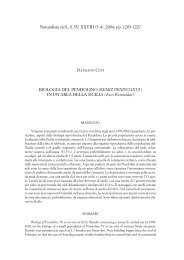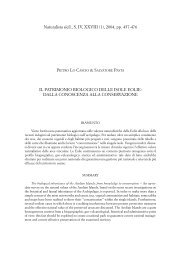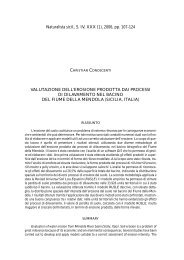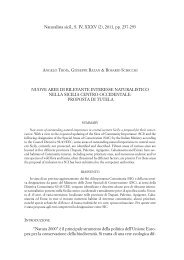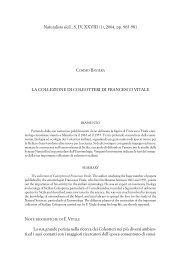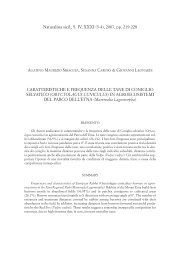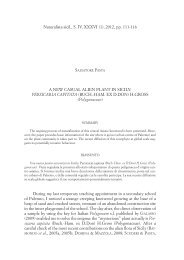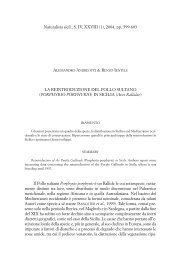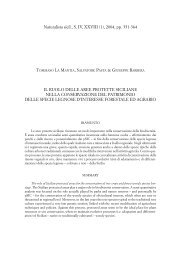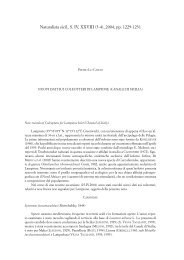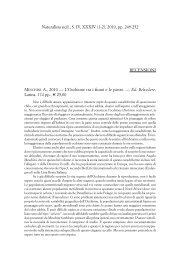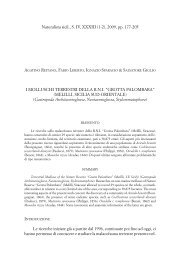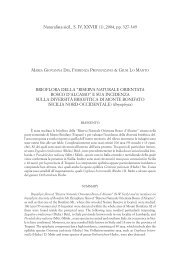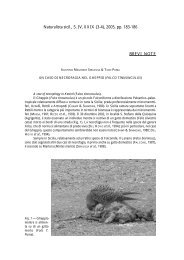2007,pp - Società Siciliana di Scienze Naturali
2007,pp - Società Siciliana di Scienze Naturali
2007,pp - Società Siciliana di Scienze Naturali
You also want an ePaper? Increase the reach of your titles
YUMPU automatically turns print PDFs into web optimized ePapers that Google loves.
294 M. SKUHRAVÁ, V. SKUHRAVY´ & B. MASSA<br />
table 1 - continued<br />
Trifolium pratense Dasineura trifolii<br />
Triticum aestivum Mayetiola destructor<br />
Contarinia tritici<br />
Verbascum sinuatum Asphondylia verbasci<br />
Vicia dasycarpa Anabremia massalongoi<br />
Contarinia craccae<br />
Dasineura viciae<br />
Vicia sativa Contarinia craccae<br />
Dasineura viciae<br />
Viola hirta Dasineura affinis<br />
Vitis vinifera Ampelosucta illata<br />
Janetiella oenephila<br />
Contarinia viticola<br />
of an European species. It occupies a large <strong>di</strong>stribution area from Britain and<br />
Portugal in Western Europe to Greece in Eastern Europe and to Algeria in<br />
North Africa.<br />
Eurosiberian species occur abundantly in Europe and extend at least to<br />
Western Siberia, some of them to central Siberia and only few species reach<br />
up to Far East, China and Japan. Dasineura rosae causing galls on leaflets of<br />
various Rosa s<strong>pp</strong>. is typical representative of Eurosiberian species.<br />
Out of 89 species of the present gall midge fauna of Sicily, one fifth (19<br />
species) were <strong>di</strong>scovered in Sicily where they have their type localities. Ten<br />
species were described by DE STEFANI PEREZ (1898, 1900, 1902, 1908, 1912,<br />
1913, 1919), namely Ampelosucta illata, Aplonyx chenopo<strong>di</strong>i, Asphondylia<br />
borzi, A. conglomerata, Dasineura minar<strong>di</strong>i, D. rufescens, Janetiella euphorbiae,<br />
Psectrosema tamaricis, Pumilomyia protrahenda, Stefaniella trinacriae.<br />
Further nine species were described by various authors based on material<br />
originated from Sicily, that is Arnol<strong>di</strong>ola tympanifex, Arthrocnodax coryligallarum,<br />
Asphondylia ca<strong>pp</strong>aris, A. stefanii, Asynapta furcifer, Dicro<strong>di</strong>plosis<br />
pseudococci, Lasioptera thapsiae, Procontarinia matteiana, Resseliella oleisuga.<br />
Unfortunately, all original materials of gall midge species <strong>di</strong>scovered in<br />
Sicily, where they have type localities, are lost with the exception of Asphondylia<br />
ca<strong>pp</strong>aris, Asynapta furcifer and Dicro<strong>di</strong>plosis pseudococci, the holotypes<br />
of which are preserved in the Museum für Naturkunde, Humboldt Universität,<br />
Berlin, Germany (A. ca<strong>pp</strong>aris), British Museum of Natural History, London,<br />
UK (A. furcifer) and New York State Museum, Albany, USA (D. pseudococci).<br />
It would be necessary to re<strong>di</strong>scover the galls of gall midges found in<br />
Sicily at their type localities, to obtain larvae, pupae and to rear adults, in<br />
order to establish the neotypes and to build a new collection of gall midges<br />
that will be preserved for future research and for redescriptions of morphological<br />
characters of larvae, pupae and adults on modern basis.



